Exact Solutions of Atmospheric(2+1)-Dimensional Nonlinear Incompressible Non-hydrostatic Boussinesq Equations∗
Ping Liu(刘萍),Ya-Xiong Wang(王亚雄),Bo Ren(任博),and Jin-Hua Li(李金花)
1College of Electron and Information Engineering,University of Electronic Science and Technology of China Zhongshan Institute,Zhongshan 528402,China
2School of Physical Electronics,University of Electronic Science and Technology of China,Chengdu 610054,China
3Institute of Nonlinear Science,Shaoxing University,Shaoxing 312000,China
4School of Physics and Optoelectronic Engineering,Nanjing University of Information Science and Technology,Nanjing,China
1 Introduction
Atmospheric gravity waves are fluctuations in the dynamic equilibrium of the gravity and buoyancy of the atmosphere.They can break,produce wind shear and typhoon,and then play a very important factor on disastrous weather and climate.The formation and propagation of atmospheric gravity waves are essential in forecasting the damage caused by rainstorm.[1−4]
The basic controlling laws of atmospheric movement are mass conservation equations,momentum conservation equations,energy conservation equations,and water mass conservation equations,and other gas and aerosol mass conservation equations.The motion of atmospheric gravity waves are mesoscale atmospheric motion,whose governing equations can be simplified from the basic governing equations of atmosphere as follows,[5]

where u and w are wind velocities in x-and z-directions,ρ means the density,T0denotes background temperature,p is the perturbation pressure,T′denotes the perturbation temperature, γ and γdare the moist lapse rate and the dry adiabatic lapse rate,g is the gravitational constant,t means the time,x and z denote the coordinates in latitudinal and vertical directions.The calculation on symmetries shows that the equations are invariant under the Galilean transformations,the scaling transformations,and the space-time translations.[6]Equations(1a)–(1b)are the kinematic equations in latitudinal and vertical directions,respectively,which are the momentum conservation equations in fluid.Equation(1c)is continuity equation,which is a mass conservation equation in fluid.Equation(1d)is the thermodynamic equation,which is an energy conservation equation in fluid.
On the(2+1)-dimensional nonlinear INHB equations,numerical simulation[7−10]and analytical analysis[1,11−13]are two commonly used methods.The interactions of atmospheric conoidal waves with a critical level are examined by using numerical simulation in Ref.[7].The authors of Ref.[8]investigated properties of solitary waves propagating in a two-layer fluid by comparing numeri-cal simulation experiments and theory,and found that stability or instability of the flow occurs in approximate with the theorem of Miles and Howard.Researchers made some effective attempts on traveling wave solutions of the(2+1)-dimensional nonlinear INHB equations.A general practice is that INHB equations are approximated to some other equations with the help of some assumptions.By Introducing traveling wave transformation and truncated expansion,the authors of Refs.[1,11]reduced the INHB equations into some known soliton equatons,such as KdV equation,KdV-mKdV equation and KdV-mKdV-GmKdV equation,and then obtained some known periodic or solitary wave solutions of these soliton equatons.In Ref.[12],the INHB equations degenerate to the KdV equation and Benjamin–Davis–Ono(BDO)equation by introduced to some boundary conditions,and then solitary wave of the KdV equation and algebraic solutions of the BDO equations are applied to describe the INHB equations.By introducing different scales of varying time and space variables,the authors of Ref.[13]reduce the INHB equations to a type of nonlinear Schrödinger equation,and then demonstrate the solitary wave evolutions of the gravity waves envelope.
Lie group symmetry theory is a very powerful method to solve partial differential equations(PDEs). Many methods on symmetries of PDEs have been proposed,such as the non-classical symmetry group,[14]the classical symmetry group,[15−17]residual symmetry,[18−19]and some other symmetry methods.[20−22]Tanh function expansion method is also a simple and useful method and is often used to research for exact solutions for PDEs.[23−25]In this paper,we will combine the tanh function method and the symmetry method to research the exact solutions of the INHB equations.
The paper is organized as follows.The tanh function is applied and 12 expansion equations governed various tanh function terms are determined in the next section.In Sec.3,the symmetries of the expansion equations are researched.Section 4 is devoted to similarity reductions and similarity solutions of the expansion equations.Exact solutions of reduction equations are discussed in Sec.5.In Sec.6,Non-traveling wave solutions of the INHB equations are obtained by symmetry method.Traveling wave solutions of the INHB equations are obtained and some evolutions of atmospheric physical quantities with space and time are graphed in Sec.7.Summary and discussion are proposed in the final section.
2 Tanh Function Expansions of the INHB Equations
For the INHB equations,we can make the following truncated tanh function expansions

where{r,u0,u1,w0,w1,p0,p1,s0,s1}are functions of x and t.Substituting Formula(2)into Eq.(1),and vanishing the coefficients of all the powers of tanh(r),we obtain 12 over-determined equations for nine undetermined functions
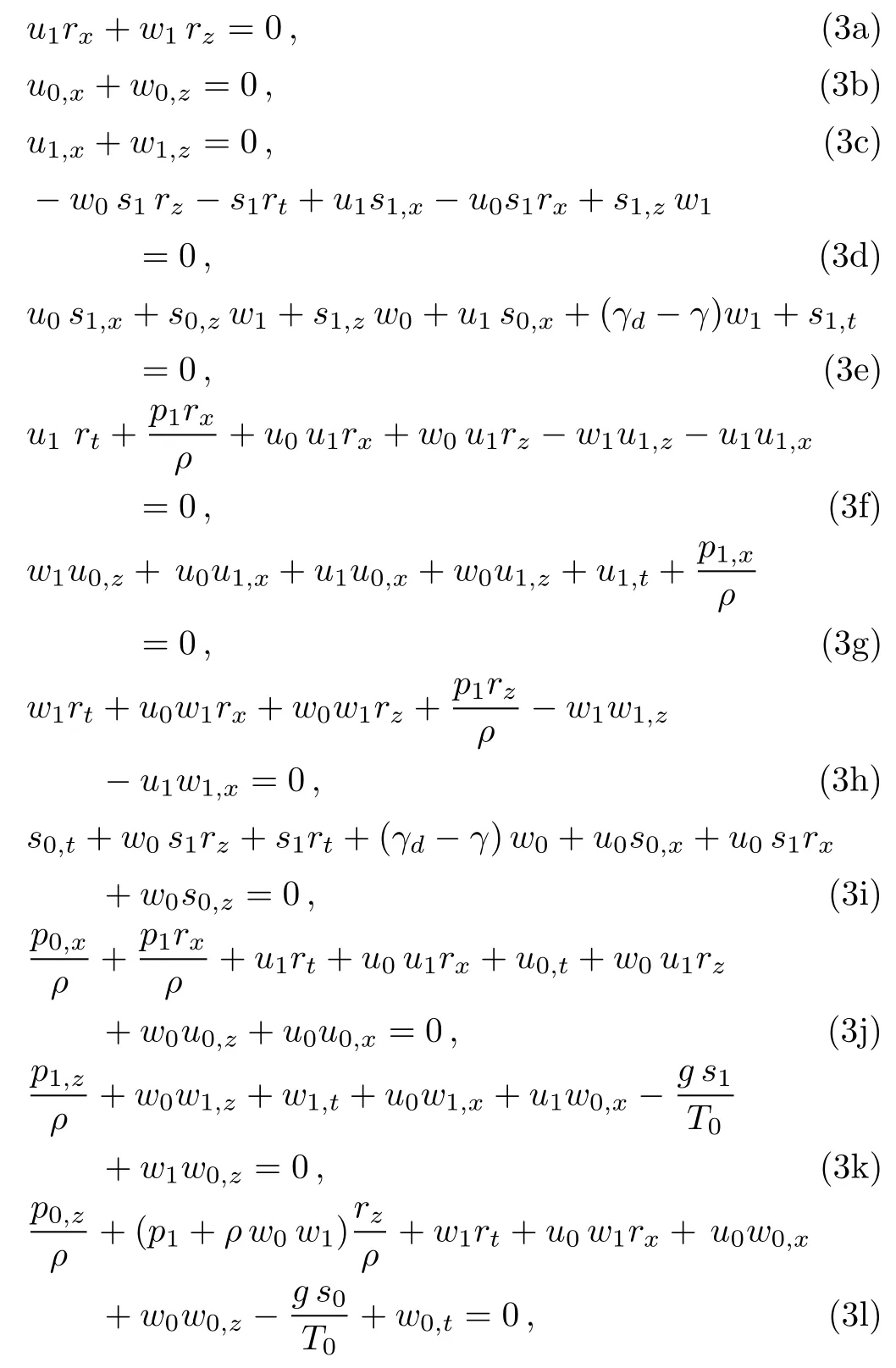
where subscripts x,z,and t represent partial differentiations.From the solutions of{u0,u1,w0,w1,p0,p1,s0,s1}and substituting these solutions into(2),we then can obtain the exact solutions of the INHB equations.It is very difficult to directly solve Eq.(3).In the next three sections,we will solve Eq.(3)with the help of symmetry group theory.
3 Symmetries of Expansion Equations
We will now try to solve Eq.(3)by means of symmetry method.A symmetry of a nonlinear partial differential equation is defined as a solution of its linearized system.The nine lie point symmetry components{σi,i=1,2,3,4,5,6,7,8,9}can be supposed to have the forms

Substituting Formula(4)into Eq.(5),and identifying the coefficients of various order terms on variables{r,u0,u1,w0,w1,p0,p1,s0,s1},we obtain an over-determined set of equations for the unknown functions.Solving the determinant equations,we obtain


where F1,F2,F3are functions of t,and{Ci,i=1,2,3,4,5,6,7}are arbitrary constants.Then symmetry components{σi,i=1,2,3,4,5,6,7,8,9}described by(4)are transformed to

4 Similarity Solutions and Reduction Equations
After determining the in finitesimal generators,the similarity variables can be found by solving the characteristic equations

Because the procedure to get the symmetry reductions is standard,we just write down the final reduction results.The most general invariant variables can be written as

Due to the existence of arbitrary functions F1(t),F2(t)and F3(t)in(7),the similarity solutions for{u0,u1,w0,w1,p0,p1,s0,s1}and the corresponding reduction equations are very lengthy,so we will discuss the simplified conditions,for example,F1(t)=F2(t)=F3(t)=0.Then we obtain the following three nontrivial types of reduction equations and similarity solutions.
Case 1C26=0,C5C6+C726=0.
In this case,the invariant variables ξ and η in(9)degenerate to

The similarity solutions can be written as

where

The reduction variables R ≡ R(ξ,η),U1≡ U1(ξ,η),W1≡ W1(ξ,η),P1≡ P1(ξ,η),S1≡ S1(ξ,η),which are arbitrary functions of ξ and η.The similarity solutions of u0,w0,p0and s0are very lengthy,so we will not write them down here.The reduction equations can be written as

Case 2C26=0,C5C6+C72=0.
The similarity solutions in this case are generated as
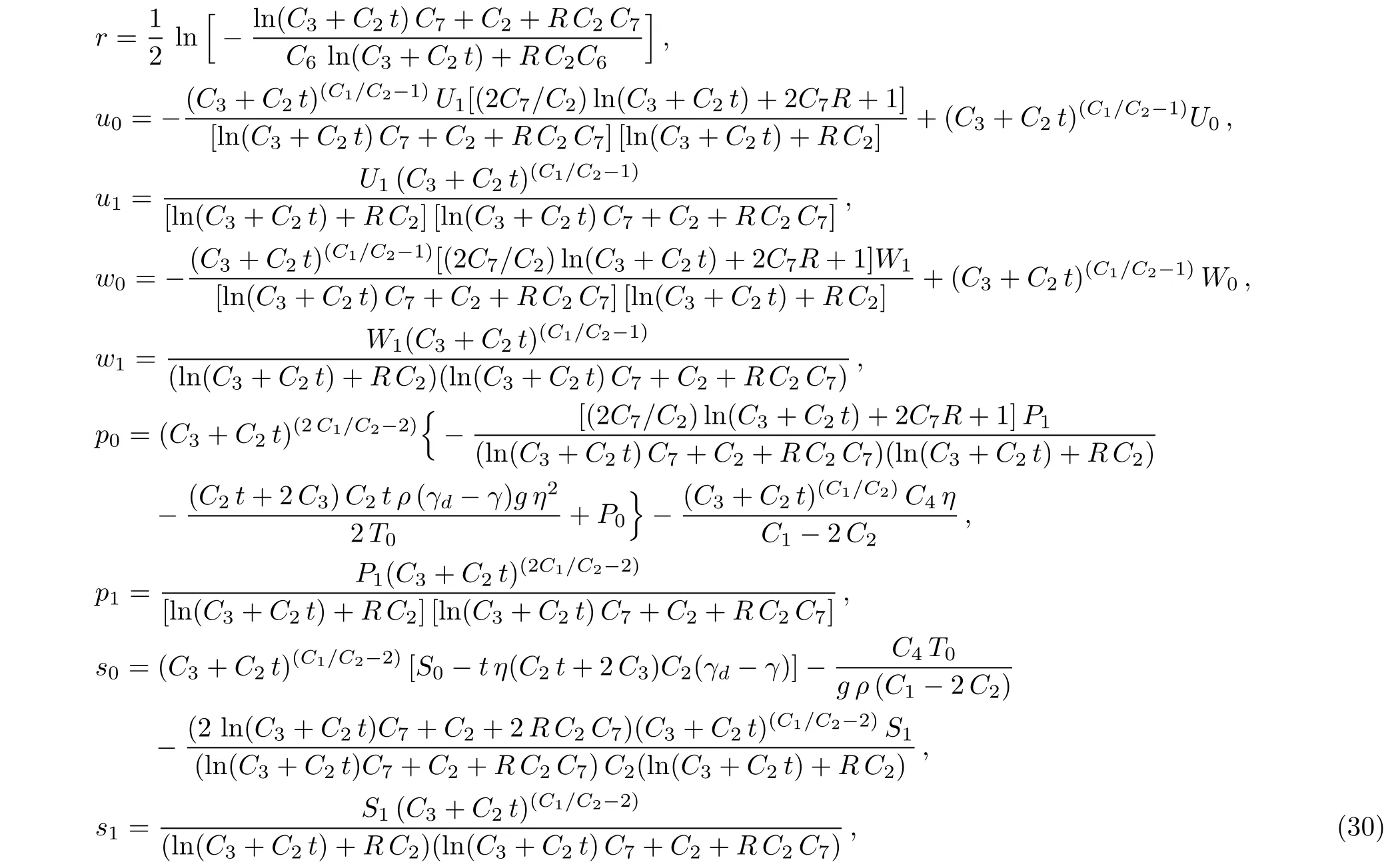
where the{U0,U1,W0,W1,P0,P1,S0,S1}are functions of group-invariant variables{ξ,η},which are determined by

The corresponding reduction equations are
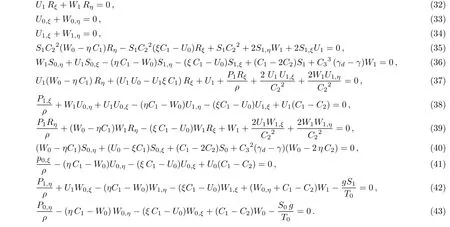
Case 3C2=0.
On condition of C2=0,the group invariant variables read

When C5C6+C726=0,the reduction equations are very complicated,and we will write only down the reduction equations on condition C5C6+C72=0.Then C5can be substituted by C5=−C72/C6,and the reduction equations are generated by

where R ≡ R(ξ,η),U0≡ U0(ξ,η),U1≡ U1(ξ,η),W0≡ W0(ξ,η),W1≡ W1(ξ,η),P0≡ P0(ξ,η),P1≡ P1(ξ,η),S0≡ S0(ξ,η),and S1≡ S1(ξ,η)are all arbitrary functions of ξ and η.
The corresponding similarity solutions are determined by
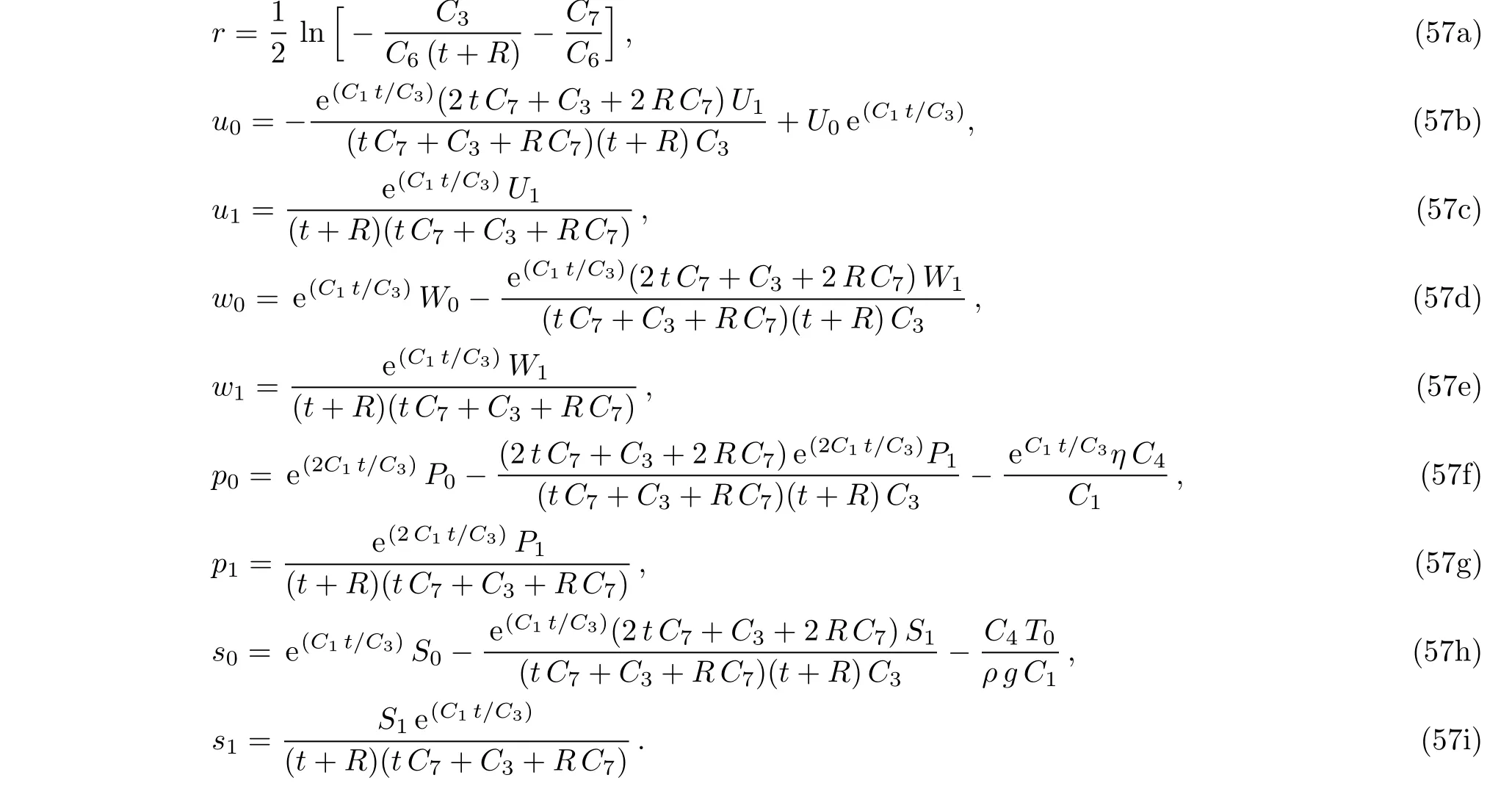
5 Exact Solutions of Reduction Equations
From similarity solutions of the researched systems and exact solutions of reduction equations,one can obtain some exact solutions of the researched systems.By this means,we can obtain some exact solutions of the expansion equations(3),and then obtain some exact solutions of the INHB equations.Three cases of similarity solutions and reduction equations are introduced in Sec.4.Obviously,different reduction equations will lead to different exact solutions of the expansion equations.
Now,we will focus on the first case of reduction equations,because it is the most general case in the three cases.Solving Eqs.(15)–(29),we obtain two types of non-trivial solutions.
Solution 1

where C9is an arbitrary constant,F5,F6,F7,F8are functions of η,which solve
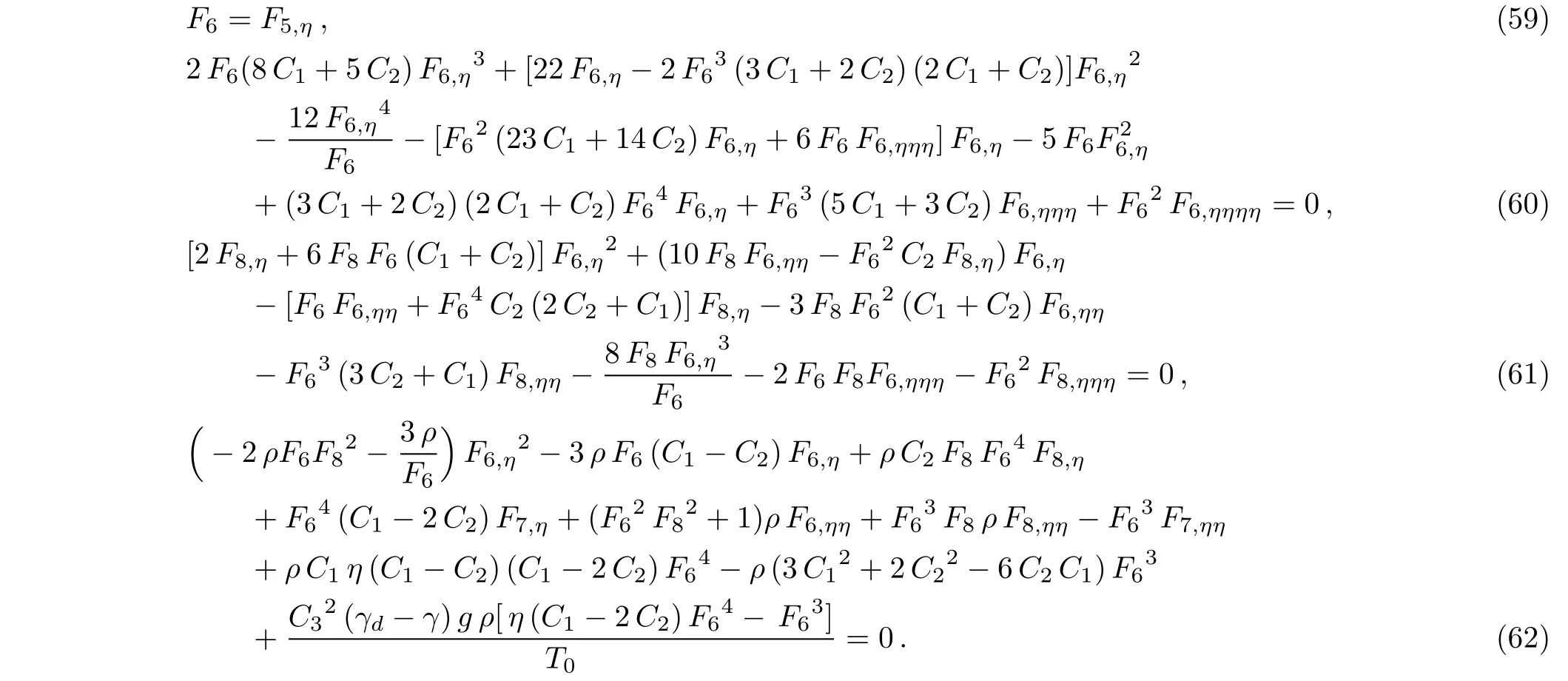
Solution 2


where F13is a function of η,and F9,F10,F11,F12,F14,and F15are functions of ξ and these functions solve the following equations:

There are some parameters bounded by constraint equations in Solution 1 and Solution 2.We can obtain the exact solutions of the first type of reduction equations only by solving these parameters.It is still very difficult to obtain general solutions of these constraint equations.So we will try to obtain some special exact solutions of the constraint equations.The method of solving the constraint equations of Solution 1 is the same as those of Solution 2,and we will only discuss Solution 1.

Plugging Formula(69)into Eqs.(59)–(62),one can obtain that

Substituting formulas(69)–(72)into Formulas(58a)–(58i),we obtain the following exact solution of the reduction equations(15)–(29)

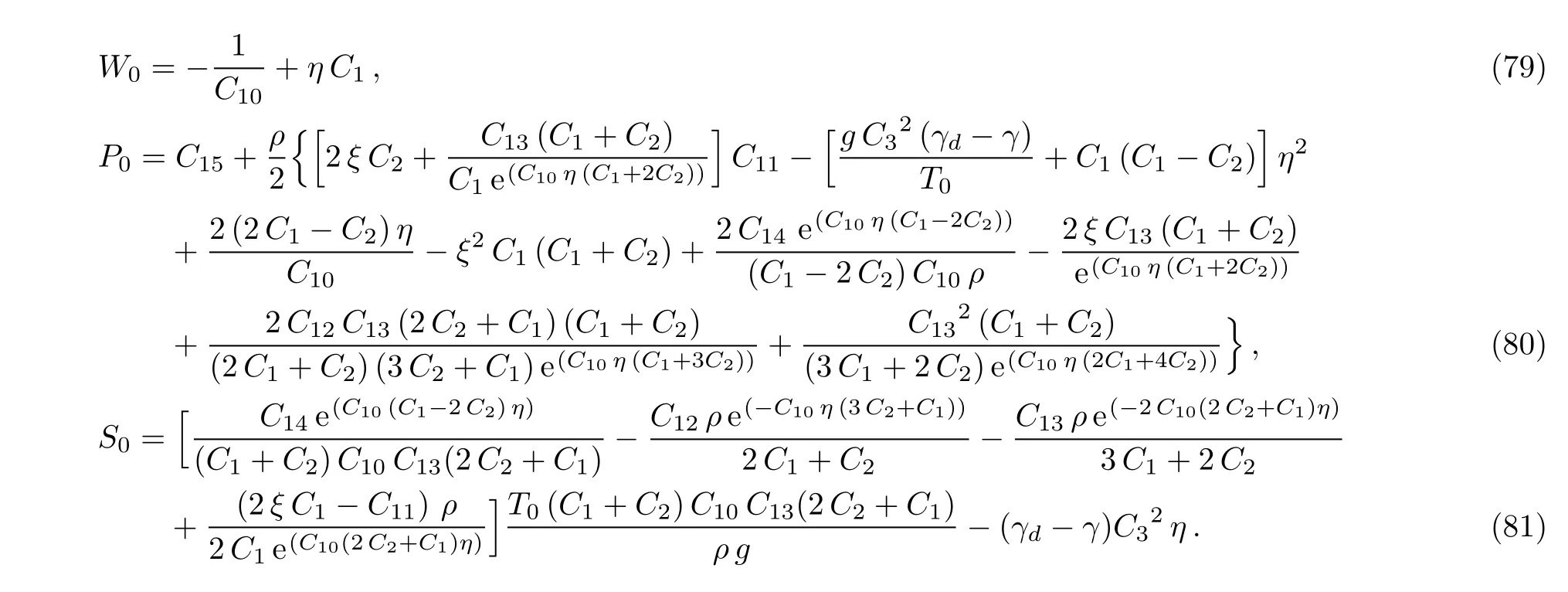
6 Non-traveling Wave Solutions of the INHB Equations
In the last section,we have obtained some exact solutions of reduction equations(15)–(29).Combining similarity solutions and the exact solutions of reduction equations,one can obtain the exact solutions of the original equations.Exact solutions of reduction equations discussed in the previous section are related to the first type of reduction equations,where the variables are{ξ,η}in(10).Because{ξ,η}in(10)are non-traveling wave transformation variables,the exact solutions obtained with the help of them are necessarily non-traveling wave solutions.To obtain traveling wave solutions of the expansion equations,one should make further transformations for the reduction equations or make directly traveling wave transformation for the expansion equations,which will be discussed in the next section.
In this section,we will try to obtain exact non-traveling wave solutions of the INHB equations by symmetry method.Plugging formulas(73)–(81)into(11a)–(11e)and noticing the auxiliary variables(12)–(14),we can obtain the solutions of{r,u0,u1,w0,w1,p0,p1,s0,s1}.The substitution of{r,u0,u1,w0,w1,p0,p1,s0,s1}into Eq.(2)leads to the solution of the INHB equations as follows:


where

and{ξ,η}are expressed as(10).
Above solution for{u,w,p,T′}in the INHB equations are non-traveling wave solutions.In the next section,we will discuss traveling wave solutions of the INHB equations.
打开床头边的手机,手机上清晰的显示着2014年1月20日,01:20:33字样。殷明看着这日期,恍然想起明天,不,是今天将在市中心有场面试。艰难地坐在床上,看着手机上的时间一分一秒流逝,电子表面的秒针嘲笑般地看着他,慢吞吞地一下一下转动着。
7 Traveling Wave Solutions of the INHB Equations
To search for traveling wave solutions on gravity waves is one important subject.We can make traveling wave transformation to{r,u0,u1,w0,w1,p0,p1,s0,s1}as follows

where k1,k2,and k3are arbitrary constants.
Equation(3)is then transformed to

Integrating Eq.(88b)once over δ,we can rewrite Eq.(88b)as

where C16are arbitrary integral constant.Then

Integrated once over δ,Eq.(88c)can be rewritten as

where C17is an arbitrary integral constant,and will be chosen as zero in the rest of this paper.Thencan be expressed as

which leads Eq.(88a)to be zero.
Substituting Formulas(90)and(92)into Eqs.(88d)–(88l),we obtain

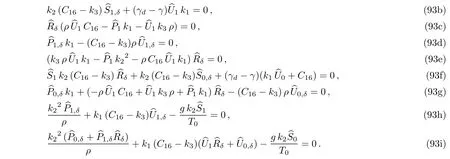
Solving Eqs.(93a)–(93i)leads to
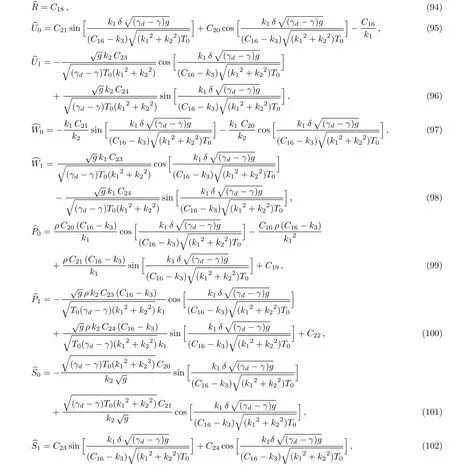
where C19–C24are arbitrary constants.
Combining Eqs.(2),(87)and(94)–(102),we obtain the exact solution for the INHB equations
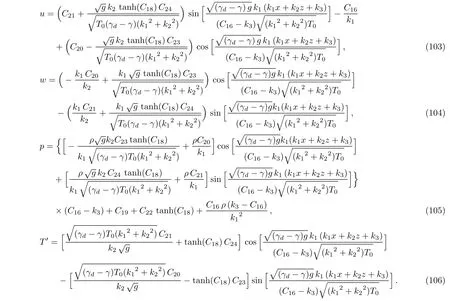

Fig.1 The evolutions of the velocities in latitudinal and vertical directions in Formulas(103)–(104).The atmospheric parameters are g=9.81 m/s2,ρ =1.29 kg/m3,γd=0.01 ◦C/m,γ =0.005 ◦C/m,T0=279 K.

Fig.2 The evolutions of perturbation pressure and perturbation temperature in Formulas(105)–(106).The atmospheric parameters are similar to Fig.1.
Figure 1 describes the evolutions for the velocities in latitudinal and vertical directions,which are governed by Formulas(103)–(104).The atmospheric parameters are g=9.81 m/s2,ρ =1.29 kg/m3,γd=0.01◦C/m,γ =0.005◦C/m,T0=279 K. C19satisfies C19=−C22tanh(C18)+C16ρ(C16−k3)/k12and the other parameters are C18=2,k1=k2=0.1,k3=0.005,C20=C21=C22=1,C23=10,C16=0,C24=10.Figure 1 demonstrates that the wind velocity evolutions in latitudinal and vertical directions can both satisfy periodic functions.The evolution of perturbation pressure with time and the evolution of perturbation temperature with time are proposed in Fig.2,which demonstrates the periodic evolutions of perturbation pressure and perturbation temperature with time and space.
On traveling wave solutions,the difference between this article and the literatures listed in Sec.1 is very obvious.The INHB equations are approximated to some other equations,and the traveling wave solutions of the approximate equation are applied to described to traveling waves solutions in the literatures.In this paper,we have not make any assumptions,and the traveling wave solutions are really exact solutions of the INHB equations.
8 Summary and Discussion
Atmospheric gravity waves play a very important role in typhoon,rainstorm,and other disastrous weather.Due to complexity,numeric simulations are often applied to atmospheric dynamical equations,while analytical analyses are much less discussed.Exact solutions and symmetries of the(2+1)-dimensional INHB equations are researched in this paper.
Tanh function expansion is applied to the INHB equations and 12 over-determined equations are determined by the expansion coefficients.Some references show that some meaningful exact solutions can be obtained by tanh function expansion method for some consistent tanh expansion(CTE)solvable systems.[23−25]Unfortunately,the INHB equations are not CTE solvable,and the auxiliary coefficient variables{r,u0,u1,w0,w1,p0,p1,s0,s1}can not be expressed intuitively as the auxiliary variable r.In order to obtain some exact solutions of the 12 coefficient equations,we introduce symmetry method to the 12 coefficient equations.Three types of non-trivial similarity solutions and the corresponding symmetry reduction equations are proposed.Combining exact solutions of reduction equations and the similarity solutions,we obtain some non-traveling wave solutions of the INHB equations.Traveling wave solutions are discussed with the help of traveling wave transformation in the paper.Some graphes on the evolutions of the latitudinal wind velocity and vertical wind velocity,perturbation pressure and perturbation temperature with space and time are demonstrated,which show directly the periodicity of some important atmospheric physical quantities with space and time.
There are still many open problems on climate and weather.The(2+1)-dimensional INHB equations,as a valuable model of atmospheric gravity waves,should be further studied.
Acknowledgements
The authors would like to thank ProfessorSen-Yue Lou and Professor Bao-Qing Zeng for their valuable discussion.
[1]Z.L.Li,J.Phys.A-Math.Theor.41(2008)145206.
[2]Z.L.Li,Appl.Math.Comput.217(2010)1398.
[3]J.R.Qing,S.M.Chen,D.W.Li,and B.Liang,Chin.Phys.B 21(2012)089401.
[4]P.Liu,Z.L.Li,and S.Y.Lou,Appl.Math.Mech.31(2010)1383.
[5]James C.McWilliams,Fundamentals of Geophysical Fluid Dynamics,Cambridge University Press,London(2006).
[6]P.Liu and X.N.Gao,Commun.Theor.Phys.53(2010)609.
[7]E.D.Shyllingstad,J.Atmos.Sci.48(1991)1613.
[8]J.Grue,A.Jensen,P.Reusas,and J.K.Sveen,J.Fluid Mech.380(1999)257.
[9]W.D.Zhao,J.Zhao,X.Z.Han,and Z.J.Xu,Chin.J.Liquid Cryst.Disp.29(2014)281.
[10]F.Qian,T.Sun,J.Guo,and T.F.Wang,Chin.J.Liquid Crys.Disp.30(2015)317.
[11]Z.L.Li,G.Fu,and J.Chen,Chaos,Solitons&Fractals 40 (2009)530.
[12]J.W.Rottman and F.Einaudi,J.Atmos.Sci.50(1993)2116.
[13]X.H.Xu and Y.H.Ding,Chin.J.Atmos.Sci.15(1991)58.
[14]G.W.Bluman and S.Kumei,Symmetries and Di ff erential Equations,Spring-Verlag,New York(1989).
[15]P.Olver,Applications of Lie Group to Di ff erential Equations,Spring-Verlag,New York(1986).
[16]P.Liu,B.Q.Zeng,B.B.Deng,and J.R.Yang,Aip Adv.5(2015)087162.
[17]P.Liu,B.Q.Zeng,and B.Ren,Commun.Theor.Phys.63(2015)413.
[18]X.N.Gao,S.Y.Lou,and X.Y.Tang,J.High Energy Phys.5(2013)029.
[19]P.Liu,B.Li,and J.R.Yang,Cent.Eur.J.Phys.12(2014)541.
[20]W.X.Ma and T.C.Xia,Phys.Scr.87(2013)055003.
[21]Z.J.Qiao,Commun.Math.Phys.239(2003)309.
[22]B.Ren,X.N.Gao,Y.Jun,and P.Liu,Open Math.13(2015)502.
[23]D.Yang,S.Y.Lou,and W.F.Yu,Commun.Theor.Phys.60(2013)387.
[24]C.L.Chen and S.Y.Lou,Chin.Phys.Lett.30(2013)110202.
[25]H.Pu and M.Jia,Commun.Theor.Phys.64(2015)623.
——浅谈写生的意义
 Communications in Theoretical Physics2016年12期
Communications in Theoretical Physics2016年12期
- Communications in Theoretical Physics的其它文章
- Pressure Oscillating Flow in Corrugated Parallel Channel∗
- The Role of a1(1260)in π−p →(1260)p and π−p → π−ρ0p Reactions Near Threshold∗
- Dilepton from Passage of Jets Through Spherical Expanding QGP∗
- Free Convective Nonaligned Non-Newtonian Flow with Non-linear Thermal Radiation
- Weibel Instability Growth Rate in Magnetized Plasmas with Quasi-Relativistic Distribution Function
- Quantum Private Comparison of Equality Based on Five-Particle Cluster State∗
